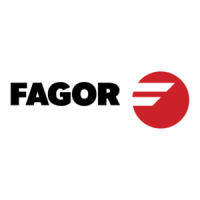
Do you have a question about the Fagor 101 and is the answer not in the manual?
| Communication | RS-232 |
|---|---|
| Programming | ISO code |
| Power Supply | 24 VDC |
| Type | CNC |
| Display | LCD |
| Operating Temperature | 0°C to 45°C |
Safety measures for personnel and product to prevent damage and ensure safe operation.
Guidelines for packing and returning CNC units for repair or replacement.
Details on OEM and User manuals for CNC models, including installation and operating guides.
Lists the sections and chapters included in the installation manual for comprehensive understanding.
Details on feedback inputs, analog outputs, axes control, interfaces, and operating options for CNC models.
Listing of inputs and outputs for CNC models, including their corresponding functions and pins.
Overview of the CNC front panel, including display windows and operational mode keys.
Accessing and configuring the peripheral mode for data transfer via RS232C serial line.
Procedure for sending CNC data (parameters, programs) to a peripheral device.
Procedure for receiving CNC data (parameters, programs) from a peripheral device.
Analyzing logic inputs and outputs status and controlling logic outputs on the CNC.
Accessing and modifying CNC machine parameters used for adapting the CNC to the machine.
Managing the internal table for tool data or zero offset values based on machine parameters.
Moving machine axes using the keyboard or external controls for positioning.
Executing programmed movements to specific coordinates for one axis at a time.
Setting or resetting coordinate values for axes, establishing a new part zero.
Performing axis homing procedures to establish machine reference points.
Basic mode for creating and modifying part programs, showing block contents.
Viewing the functions programmed within specific blocks of a part program.
Step-by-step guide to editing block contents, entering functions, and modifying values.
Procedures for removing content from individual blocks or clearing the entire program memory.
Selecting execution modes (Single Block, Automatic) and starting program runs.
Methods for pausing program execution and resuming or analyzing the program.
Selecting various information types to display during program execution for monitoring.
Switching between Automatic and Single-Block modes while a program is running.
Structure and syntax rules for creating part programs, including ISO-coded functions.
Overview of G-functions used to define geometry and work conditions in CNC programming.
Understanding block numbering, conditional blocks, metric/inch programming, and coordinate systems.
Establishing and understanding machine reference zero, part zero, and machine reference points.
Applying zero offsets to align coordinates with part blueprints, including preset and table loading.
Details on functions like Feedrate (F), Spindle Speed (S), Tool Number (T), and Auxiliary (M).
Functions for controlling axis movement paths like Rapid Positioning (G00) and Linear Interpolation (G01).
Functions for Dwell (G04), Part Counter Increment (G45), and Cornering (G05, G07).
Functions for Feedback Inhibit (G47, G48) and Feedrate adjustments (G61, G62).
Functions for Batch Programming (G81), Probing (G75), and Rigid Tapping (G84, G80).
Using parameters to create flexible programs, including assignments and operations.
Comprehensive list of error codes, their meanings, and potential causes for CNC operation.
Summary of updates and changes in software versions, including corrections to manuals.